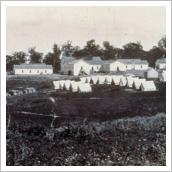by Erin Holaday Ziegler
A Kentucky-produced educational film on the state's archaeology did more than just debut on the west coast.
"Historic Archaeology: Beneath Kentucky's Fields and Streets," produced by the Kentucky Archaeological Survey (KAS), the Kentucky Heritage Council (KHC) and Voyageur Media Group, Inc, garnered three awards at the 8th Annual Archaeology Channel International Film and Video Festival in Eugene, Ore. This program, the third volume in the council's popular “Kentucky Archaeology” series, was made possible with support from the Federal Highway Administration and the Kentucky Transportation Cabinet.
Chosen as one of only 18 films screened in front of judges and an audience during this year's festival, the film won for Best Script and Best Public Education Value, and was one of three finalists in the Most Inspirational category.
The Archaeological Channel (TAC) Film Festival presented documentaries from production companies creating programs for such international networks as Tokyo Broadcasting System and WGBH/NOVA (PBS), according to executive producers David Pollack and Gwynn Henderson of the KAS. Producers and distributors from 20 countries worldwide submitted 69 film entries to the festival.
"A jury of five professionals recognized that our film was the best in those categories," said Henderson, KAS Education Coordinator and a UK adjunct anthropology professor. "And it all goes back to collaboration between scholars and the folks who are producing, directing and editing."
"The 'Kentucky Archaeology' series is successful because so many scholars - with diverse perspectives and skills - collaborate in the development process, from concept meetings through script development to the final program," said Voyageur Media Group President Tom Law. "We are pleased to see that this prestigious international film festival also recognizes the vital role scholars play in the creation of quality educational media."
"Historic Archaeology: Beneath Kentucky's Fields and Streets" examines what archaeologists have learned about the daily lives of Euro-American settlers, slaves, laborers, and immigrants during the late 1700s and 1800s. The one-hour documentary travels to historic sites across Kentucky, merging interviews with archaeologists, videos of archaeologists working in the field and laboratory, archival photographs, and original animation.
Sites highlighted in the film include Boonesborough State Park; Ashland, the Henry Clay Estate; Farmington Historic Plantation; Riverside, the Farnsley-Moremen Landing; the Old Frankfort Cemetery; Camp Nelson Civil War Heritage Park; Battery Hooper; and Portland Wharf Historic Park.
The Public Education award is very significant to those involved in the film, as education is one of the primary goals of the series.
"Our main mission at KAS is public education and specifically, educating Kentucky citizens about their rich cultural heritage," said Pollack, Director of the KAS and a UK adjunct anthropology professor. "Research is important, but archaeologists also have a responsibility to let the public know what we learn from these studies, and this award means that we're achieving our goal."
Henderson has seen a growing interest in archaeology, as well as Kentucky history and prehistory in her work throughout the state. "People are interested, because there's a connection to the past," she said. "The subject has its own bells and whistles."
The Archaeology Channel International Film and Video Festival is one of approximately eight competitive festivals featuring archaeology-related films worldwide and the only one in the Western Hemisphere.
The film, which is available on DVD from the KHC, has been broadcast on KET and in local Kentucky schools. KET will distribute the DVD, along with lessons KAS developed to accompany the program, to arts and social studies teachers during a professional development academy at KET this month.
